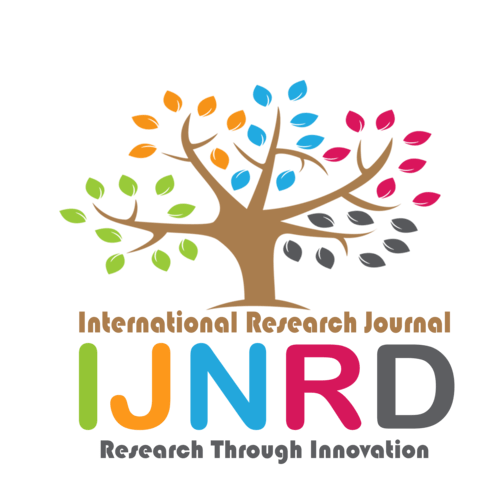|
|||||||||||||||

|
INTERNATIONAL JOURNAL OF NOVEL RESEARCH AND DEVELOPMENT International Peer Reviewed & Refereed Journals, Open Access Journal ISSN Approved Journal No: 2456-4184 | Impact factor: 8.76 | ESTD Year: 2016 Scholarly open access journals, Peer-reviewed, and Refereed Journals, Impact factor 8.76 (Calculate by google scholar and Semantic Scholar | AI-Powered Research Tool) , Multidisciplinary, Monthly, Indexing in all major database & Metadata, Citation Generator, Digital Object Identifier(DOI) |
||||||||||||||
Issue: May 2024
Volume 9 | Issue 5
Review Result and Publication of Paper within : 2-3 days
Click Here For more DetailsFor Authors
Forms / Download
Published Issue Details
Editorial Board
Other IMP Links
Facts & Figure
Impact Factor : 8.76
Issue per Year : 12
Volume Published : 9
Issue Published : 96
Article Submitted :
Article Published :
Total Authors :
Total Reviewer :
Total Countries :
Indexing Partner
Join RMS/Earn 300
Licence
This work is licensed under a Creative Commons Attribution-NonCommercial 4.0 International License







|
Published Paper Details
|
|
| Paper Title: | COMPARATIVE ANALYSIS OF TELEMEDICINE PROGRAMS IN INDIA AND OTHER COUNTRIES, AND TO PROPOSE SOLUTIONS FOR ADDRESSING THE CHALLENGES ASSOCIATED WITH TELEMEDICINE IMPLEMENTATION |
| Authors Name: | Namrata S. Agrol |
| Download E-Certificate: | Download |
| Author Reg. ID: |
IJNRD_203578
|
| Published Paper Id: | IJNRD2308154 |
| Published In: | Volume 8 Issue 8, August-2023 |
| DOI: | |
| Abstract: | Telemedicine, employing telecommunication technology for delivering remote healthcare services, has experienced significant growth in India and other nations. This summary discusses the adoption, obstacles, and potential of telemedicine in India and globally. In India, telemedicine has evolved into an innovative solution to tackle the limited healthcare infrastructure, geographic barriers, and an extensive population. The Indian government proactively supports telemedicine adoption with initiatives such as the 2020. Telemedicine Practice Guidelines. These guidelines establish a legal structure and regulatory clarity, ensuring patient safety, data privacy, and compatibility of telemedicine systems. The COVID-19 pandemic facilitated remarkable progress for telemedicine in India. The crisis accelerated the recognition of telemedicine as a secure and convenient alternative to traditional consultations. A significant increase in virtual visits occurred throughout the nation. Telemedicine has been crucial in enhancing healthcare access for individuals in rural and underserved locations with limited healthcare facilities availability. It has connected patients with specialists for remote consultations while reducing travel time and costs. India's telemedicine offers numerous advantages such as improved healthcare services access, convenience, cost-effectiveness, and consistent care. It holds the potential to ease the strain on the healthcare system, minimize unnecessary hospital visits, and improve patient results. Telemedicine startups have become essential in the Indian healthcare landscape by using technology to link patients with doctors, facilitate online consultations, and distribute medicines directly to patients' homes. Despite substantial progress, telemedicine in India still faces challenges like inadequate internet access in rural locations, low digital health literacy, and data privacy and security concerns. Sustained policy support, infrastructure improvements, and public awareness campaigns are crucial for ensuring a stable expansion of telemedicine throughout India. In various nations, the utilization of telemedicine has progressively expanded, with differing rates of adoption and execution across different healthcare systems. Developed countries like the United States, Canada, and Australia have pioneered telemedicine implementation over the past several years. These nations possess comprehensive telemedicine frameworks, well-formulated reimbursement mechanisms, and strong technical infrastructure. Telemedicine has been widely integrated into numerous healthcare domains such as primary care, specialty care, and remote patient monitoring. In developing countries, telemedicine has demonstrated its potential to enhance healthcare accessibility and reduce disparities among populations. Nations such as Brazil, Mexico, and South Africa have adopted telemedicine to tackle geographical obstacles, facilitating connections between patients and healthcare providers while fortifying their healthcare systems. Telemedicine has proven valuable in addressing the scarcity of healthcare professionals in remote regions while also improving access to specialized care and ameliorating disease management strategies. The onset of the COVID-19 pandemic has considerably accelerated global telemedicine adoption. A significant increase in telehealth utilization has been observed across nations, emphasizing its importance during times of crisis. Telemedicine has provided an essential solution for maintaining continuity of care by minimizing infection exposure risks and enabling remote observation of patients' well-being. Technological advancements in areas such as artificial intelligence, remote monitoring devices, and virtual reality are expected to enrich telemedicine capabilities in the future. The integration of Internet of Things (IoT) devices and smart home technologies will facilitate seamless data collection and monitoring procedures. This transformative approach in healthcare delivery will empower individuals to take charge of their health management. In conclusion, telemedicine has emerged as a crucial aspect of healthcare delivery systems in India and other countries worldwide. It possesses the capacity to surmount distance-related barriers while enhancing access to medical care and improving patient outcomes. Although challenges remain, increasing adaptation rates, government backing, and technological progress allude to a bright future for telemedicine. Ongoing collaboration, innovation, and policy support are crucial in unlocking telemedicine's full potential to transform global healthcare. The study utilized secondary data such as research articles, magazines, news, books for the development of the true knowledge of telemedicine. The comprehensive analysis of diverse facets of telemedicine in India encompasses significant projects endorsed by various governmental ministries, endeavors undertaken by healthcare and academic institutions, standardization and policy reforms, scholarly publications and organizational undertakings, human resource development, and industry nuances. Numerous stakeholders contribute to this field, yet no single repository of information exists. In assembling data about these categories of telemedicine programs throughout the nation, we employed a multifaceted approach and accessed an array of sources. The resulting information was meticulously compiled, scrutinized, and synthesized, culminating in the research article presented herein. |
| Keywords: | Telemedicine, Digital Health literacy, IoT |
| Cite Article: | "COMPARATIVE ANALYSIS OF TELEMEDICINE PROGRAMS IN INDIA AND OTHER COUNTRIES, AND TO PROPOSE SOLUTIONS FOR ADDRESSING THE CHALLENGES ASSOCIATED WITH TELEMEDICINE IMPLEMENTATION", International Journal of Novel Research and Development (www.ijnrd.org), ISSN:2456-4184, Vol.8, Issue 8, page no.b440-b460, August-2023, Available :http://www.ijnrd.org/papers/IJNRD2308154.pdf |
| Downloads: | 000118771 |
| ISSN: |
2456-4184 | IMPACT FACTOR: 8.76 Calculated By Google Scholar| ESTD YEAR: 2016 An International Scholarly Open Access Journal, Peer-Reviewed, Refereed Journal Impact Factor 8.76 Calculate by Google Scholar and Semantic Scholar | AI-Powered Research Tool, Multidisciplinary, Monthly, Multilanguage Journal Indexing in All Major Database & Metadata, Citation Generator |
| Publication Details: |
Published Paper ID:IJNRD2308154 Registration ID: 203578 Published In: Volume 8 Issue 8, August-2023 DOI (Digital Object Identifier): Page No: b440-b460 Country: Mumbai, Maharashtra, India Research Area: Science Publisher : IJ Publication Published Paper URL : https://www.ijnrd.org/viewpaperforall?paper=IJNRD2308154 Published Paper PDF: https://www.ijnrd.org/papers/IJNRD2308154 |
| Share Article: | |
|
Click Here to Download This Article |
|
| Article Preview | |
|
|
|
Major Indexing from www.ijnrd.org
| Semantic Scholar | Microsaoft Academic | ORCID | Zenodo |
| Google Scholar | ResearcherID Thomson Reuters | Mendeley : reference manager | Academia.edu |
| arXiv.org : cornell university library | Research Gate | CiteSeerX | PUBLON |
| DRJI | SSRN | Scribd | DocStoc |
ISSN Details
 |
 |
ISSN: 2456-4184
Impact Factor: 8.76 and ISSN APPROVED
Journal Starting Year (ESTD) : 2016
DOI (A digital object identifier)
Conference
Open Access License Policy
Important Details
Social Media
| Copyright © 2024 - All Rights Reserved - IJNRD |












Facebook Twitter Instagram LinkedIn